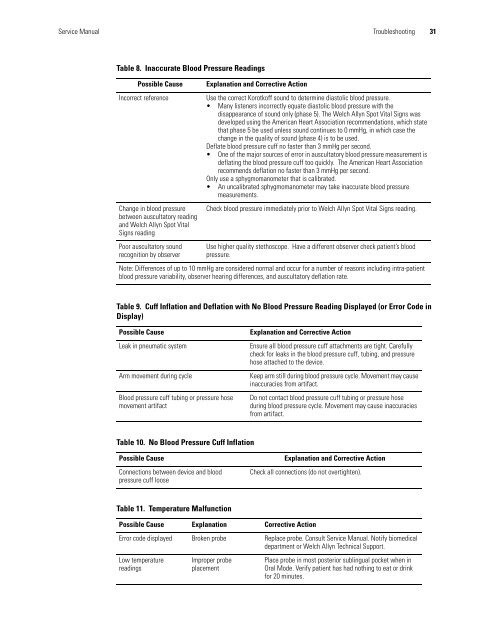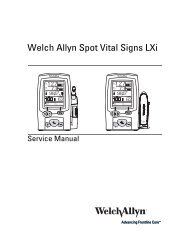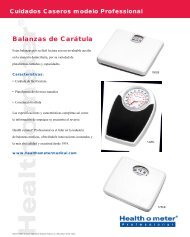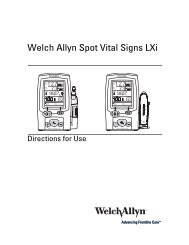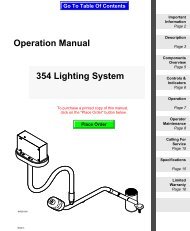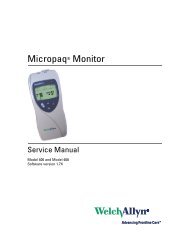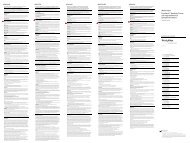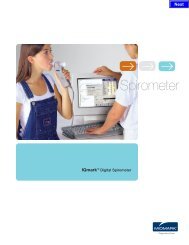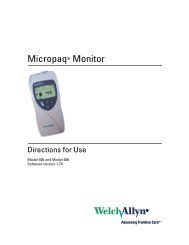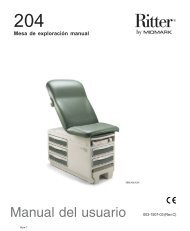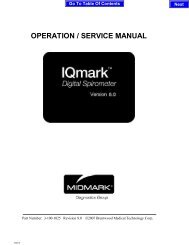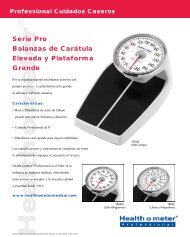Spot Vital Signs Service Manual - Frank's Hospital Workshop
Spot Vital Signs Service Manual - Frank's Hospital Workshop
Spot Vital Signs Service Manual - Frank's Hospital Workshop
Create successful ePaper yourself
Turn your PDF publications into a flip-book with our unique Google optimized e-Paper software.
<strong>Service</strong> <strong>Manual</strong> Troubleshooting 31<br />
Table 8. Inaccurate Blood Pressure Readings<br />
Possible Cause Explanation and Corrective Action<br />
Incorrect reference Use the correct Korotkoff sound to determine diastolic blood pressure.<br />
Many listeners incorrectly equate diastolic blood pressure with the<br />
disappearance of sound only (phase 5). The Welch Allyn <strong>Spot</strong> <strong>Vital</strong> <strong>Signs</strong> was<br />
developed using the American Heart Association recommendations, which state<br />
that phase 5 be used unless sound continues to 0 mmHg, in which case the<br />
change in the quality of sound (phase 4) is to be used.<br />
Deflate blood pressure cuff no faster than 3 mmHg per second.<br />
One of the major sources of error in auscultatory blood pressure measurement is<br />
deflating the blood pressure cuff too quickly. The American Heart Association<br />
recommends deflation no faster than 3 mmHg per second.<br />
Only use a sphygmomanometer that is calibrated.<br />
An uncalibrated sphygmomanometer may take inaccurate blood pressure<br />
measurements.<br />
Change in blood pressure<br />
between auscultatory reading<br />
and Welch Allyn <strong>Spot</strong> <strong>Vital</strong><br />
<strong>Signs</strong> reading<br />
Poor auscultatory sound<br />
recognition by observer<br />
Check blood pressure immediately prior to Welch Allyn <strong>Spot</strong> <strong>Vital</strong> <strong>Signs</strong> reading.<br />
Use higher quality stethoscope. Have a different observer check patient’s blood<br />
pressure.<br />
Note: Differences of up to 10 mmHg are considered normal and occur for a number of reasons including intra-patient<br />
blood pressure variability, observer hearing differences, and auscultatory deflation rate.<br />
Table 9. Cuff Inflation and Deflation with No Blood Pressure Reading Displayed (or Error Code in<br />
Display)<br />
Possible Cause Explanation and Corrective Action<br />
Leak in pneumatic system Ensure all blood pressure cuff attachments are tight. Carefully<br />
check for leaks in the blood pressure cuff, tubing, and pressure<br />
hose attached to the device.<br />
Arm movement during cycle Keep arm still during blood pressure cycle. Movement may cause<br />
inaccuracies from artifact.<br />
Blood pressure cuff tubing or pressure hose<br />
movement artifact<br />
Table 10. No Blood Pressure Cuff Inflation<br />
Do not contact blood pressure cuff tubing or pressure hose<br />
during blood pressure cycle. Movement may cause inaccuracies<br />
from artifact.<br />
Possible Cause Explanation and Corrective Action<br />
Connections between device and blood<br />
pressure cuff loose<br />
Table 11. Temperature Malfunction<br />
Check all connections (do not overtighten).<br />
Possible Cause Explanation Corrective Action<br />
Error code displayed Broken probe Replace probe. Consult <strong>Service</strong> <strong>Manual</strong>. Notify biomedical<br />
department or Welch Allyn Technical Support.<br />
Low temperature<br />
readings<br />
Improper probe<br />
placement<br />
Place probe in most posterior sublingual pocket when in<br />
Oral Mode. Verify patient has had nothing to eat or drink<br />
for 20 minutes.


